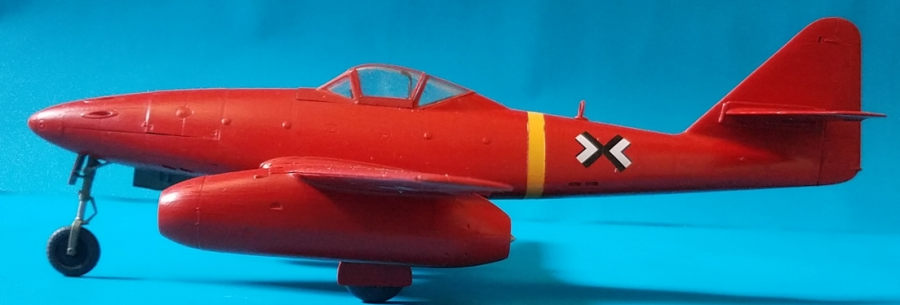
| KIT #: | 80369 |
| PRICE: | $16.00 |
| DECALS: | Two options |
| REVIEWER: | Francisco Santoro |
| NOTES: | Aircraft painted as the Jet Striker from the Strike Witches 2 anime. |

| HISTORY |
From the Strike Witches wiki: "Etherjet
Strikers (commonly known as jet strikers) were invented by researchers in
Karlsland and built in Neue Karlsland. They are faster and more powerful than an
average striker unit. It was able to ascend really fast. However, only witches
with strong magical capabilities as well as support from their familiar can
safely use them, and it didn't seem good for flying for a long period of time.
Although they're very powerful an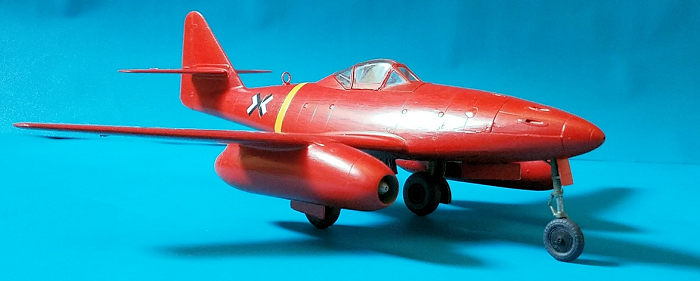 d
faster, a defect in the machine caused the first test pilots to suffer from
heavy magic power consumption and made them crash. The strikers have two cohets
that, as the striker unit runs on magic power, the shock diamonds appear as
disks similar to the rune shields used by the witches. While it depends on the
model, Jet Strikers are usually capable of a maximum speed of about 950 km/h.
d
faster, a defect in the machine caused the first test pilots to suffer from
heavy magic power consumption and made them crash. The strikers have two cohets
that, as the striker unit runs on magic power, the shock diamonds appear as
disks similar to the rune shields used by the witches. While it depends on the
model, Jet Strikers are usually capable of a maximum speed of about 950 km/h.
The main model of the Jet Strikers is the Messerscharf Me 262, with sub-models as the V1 and the A-1a. On May 22 of 1943, Air vice-marshal Adolfine Galland from the Karlslander Air Force performed a test-flight with the Me 262. Afterwards, she proposed its manufacture in an imperial conference and Frederick IV, a known lover of new technology, accepted it. Galland had high hopes in this model. Initial testing looked promising. The 262 set a new altitude record of 16,000+ meters. In spring of 1945, Ursula Hartmann developed the first Jet Striker Unit prototype, the ME-262 Swallow, which was delivered to the 501st JFW for testing. Gertrud Barkhorn tested it, and during its third test of speed, Barkhorn fainted and crashed into the Adriatic Sea. The Prototype was then locked away and was scheduled to be sent back for further development. After scrambling to intercept a Neuroi, the prototype fell to its destruction. The remains of it were sent back with Ursula Hartmann. Post war, Jet Striker prototypes became the main focus of development."
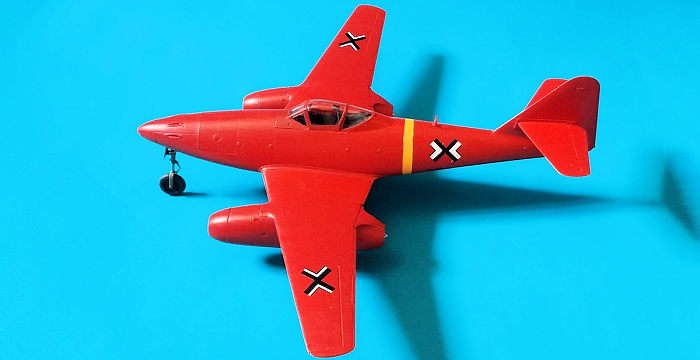 Real life
description from the Tamiya Me 262A-1a: "Development of the Me 262, the first
practical jet powered fighter in the world, started in 1939. In July 18th 1942,
Me 262V3 made its flight with two Junkers Jumo 004 jet engines. After prototypes
featuring nose housed landing gear and improvem Jumo 004B engines, the first
production model of the Me 262 was completed. Capable of 870km/h top speed, the
Me 262 featured 18,5 degree receding wings. With Allied bombing raids on the
German homeland were rapidly intensifying, the Luftwaffe proposed the hastened
deployment of the of the revolutionary Me 262 as a jet fighter/interceptor.
However, Hitler issued strict contrary orders prioritizing the deployment of the
A-2a fighter bomber version of the Me 262. Despite these orders, the A-1a
assigned to Me 262 test/training units (Ekdo 262) were deployed to intercept and
succesfully shot down Allied Mosquitoes and Spitfires. On September 1944, the
first practical unit was organized and on November 4th, full scale production of
the Me 262A-1a was permitted at last. Me 262A-1a fighters were assigned to units
such as JG7 (organized based on Ekdo 262) and KG (J) 54 (re-orginised from
bomber unit to fighter unit). On April 1945, just before the end of WW2,
Lieutenant Galland organized an elite unit of ace piloted Me 262A-1a fighters as
JV44. Although the Luftwaffe was on its last wing, ace flown Me 262A-1a fighters
packed with deadly armaments of four MK108 30mm cannons, as well as W.Gr 21 and
R4M air-to-air rockets continued to threaten Allied aircraft until the end of
the war."
Real life
description from the Tamiya Me 262A-1a: "Development of the Me 262, the first
practical jet powered fighter in the world, started in 1939. In July 18th 1942,
Me 262V3 made its flight with two Junkers Jumo 004 jet engines. After prototypes
featuring nose housed landing gear and improvem Jumo 004B engines, the first
production model of the Me 262 was completed. Capable of 870km/h top speed, the
Me 262 featured 18,5 degree receding wings. With Allied bombing raids on the
German homeland were rapidly intensifying, the Luftwaffe proposed the hastened
deployment of the of the revolutionary Me 262 as a jet fighter/interceptor.
However, Hitler issued strict contrary orders prioritizing the deployment of the
A-2a fighter bomber version of the Me 262. Despite these orders, the A-1a
assigned to Me 262 test/training units (Ekdo 262) were deployed to intercept and
succesfully shot down Allied Mosquitoes and Spitfires. On September 1944, the
first practical unit was organized and on November 4th, full scale production of
the Me 262A-1a was permitted at last. Me 262A-1a fighters were assigned to units
such as JG7 (organized based on Ekdo 262) and KG (J) 54 (re-orginised from
bomber unit to fighter unit). On April 1945, just before the end of WW2,
Lieutenant Galland organized an elite unit of ace piloted Me 262A-1a fighters as
JV44. Although the Luftwaffe was on its last wing, ace flown Me 262A-1a fighters
packed with deadly armaments of four MK108 30mm cannons, as well as W.Gr 21 and
R4M air-to-air rockets continued to threaten Allied aircraft until the end of
the war."
| THE KIT |
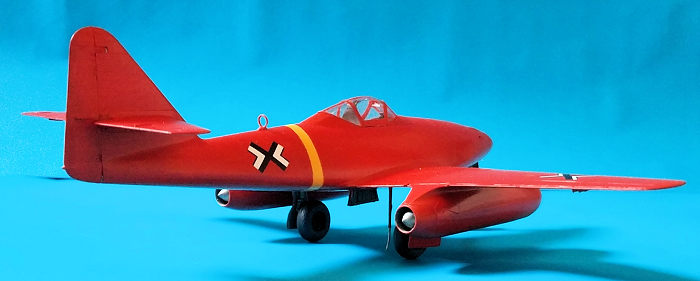 The
kit comes in a top opening box with a nightfighter Me 262A-1a flying. There're a
total of 11 sprues, 9 in light grey and two in clear plastic. The parts have
finely done panel lines, and the aircraft is covered in rivets. The kit also
comes with a nose weight in the shape of the nose landing gear well, just as the
Tamiya kit (there's also a plastic nose gear well too).
The
kit comes in a top opening box with a nightfighter Me 262A-1a flying. There're a
total of 11 sprues, 9 in light grey and two in clear plastic. The parts have
finely done panel lines, and the aircraft is covered in rivets. The kit also
comes with a nose weight in the shape of the nose landing gear well, just as the
Tamiya kit (there's also a plastic nose gear well too).
Instructions are of the black and white type in a booklet style, there're 7 construction steps in total. The kit also comes with a fully coloured painting and decalling page. There're two decal options (mixed in the painting instructions):
1) Me 262A-1a "Red 2" of 10/NAGe 11, painted in RLM 81/82/22.
2) Me 262A-1A 9K+LK of I/KG51, 1945, painted in RLM 81/82/76.
| CONSTRUCTION |
After taking a look at the instructions, I realised this kit is similar to its big brother, the Trumepeter 1:32 Me 262A. Excepting the flaps, slats and ailerons, which come moulded into the wings, everything is the same as the Trumpeter offering.
Back to the kit, I began by painting all the cockpit parts in RLM 66 (Revell 78), and the fuselage interior parts in RLM 02 (Revell 45) After all that was dry, I assembled it together and left them to dry.
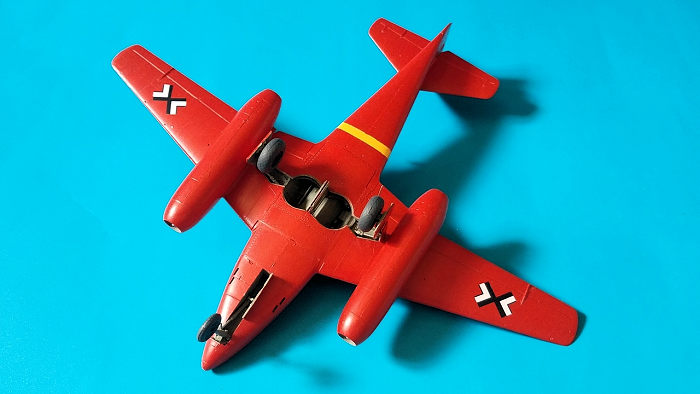 Next
came the machinecannon bay. I didn't paint those parts since they were going to
be covered by the hatches. I finished building them and the gun bay was glued to
the metal nose gear well with epoxy glue. After glueing the gun bay to the metal
nose weight, the instructions tell you to add the nose landing gear strut, but
you can safely add the strut after the aircraft is fully painted and decalled.
Next
came the machinecannon bay. I didn't paint those parts since they were going to
be covered by the hatches. I finished building them and the gun bay was glued to
the metal nose gear well with epoxy glue. After glueing the gun bay to the metal
nose weight, the instructions tell you to add the nose landing gear strut, but
you can safely add the strut after the aircraft is fully painted and decalled.
I next glued the nose gear/gun bay into the fuselage. The first one was glued with CA, and the cockpit was glued in place with regular Revell Contacta Glue. After that, I glued the nose and gun cover into the fuselage. At this point, you have the option of glueing the cannon hatches open or closed. I decided to close them, because I like the look of a clean Me 262. Before closing up the fuselage, I glued an extra 30 grams weight inside the aircraft, since I didn't know if the supplied nose weight would be enough to avoid a tail sitter.
I then glued the horizontal stabilizers and the rudder, together with the fully built up wings,to the fuselage. I then built up the engines and glued them to the wings.
| COLORS & MARKINGS |
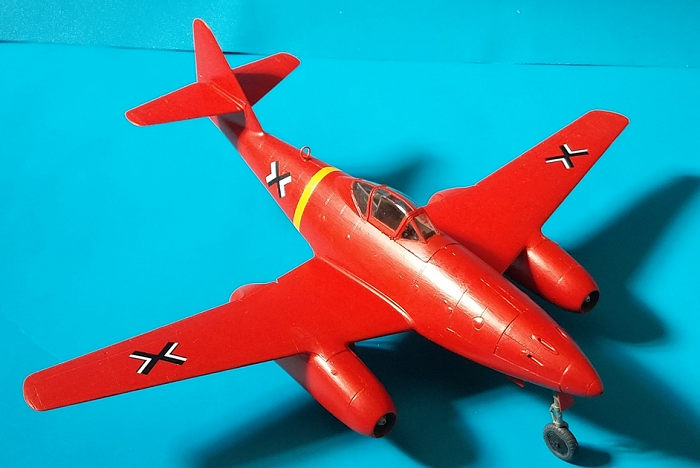 The
Jet Striker V1 of Strike Witches 2 is painted entirely in red with a yellow band
on the aft of the fuselage. Before painting the red, I primed the entire model
in white (Revell 05), to give the red a good surface to stick to. I first
painted the yellow band (Revell 14), and then painted the red (Revell 36). I
then covered the model with two coats of Revell's gloss varnish to prepare the
surface for the decals.
The
Jet Striker V1 of Strike Witches 2 is painted entirely in red with a yellow band
on the aft of the fuselage. Before painting the red, I primed the entire model
in white (Revell 05), to give the red a good surface to stick to. I first
painted the yellow band (Revell 14), and then painted the red (Revell 36). I
then covered the model with two coats of Revell's gloss varnish to prepare the
surface for the decals.
The Karlslandian Luftwaffe has a similar insignia to the real life WW2 Luftwaffe, but the Iron Cross in split in half, making an X. The crosses came from an Eagle Cals decal sheet. After letting the decals dry for 24 hours, I coated the entied model with two brush coats of Revell's matt varnish.
I painted the landing gear in RLM 02 and the wheels in RLM 66 with black hubs. These pieces were then glued into the plane, and left to set before putting the aircraft on its wheels. The clear parts were the last pieces to be glued into the model.
| CONCLUSIONS |
Painting this kit in an all red colour scheme is a change of pace compared to the regular 262s painted in the Luftwaffe late war colours. The Hobby Boss kit is recommended for those who donīt have the money to buy the Tamiya kit.
| REFERENCES |
Tamiya's Me 262A-1a instructions.
This link of the Strike Witches wiki: https://worldwitches.fandom.com/wiki/Striker_UnitThe st
Francisco Santoro
2 May 2021 Copyright ModelingMadness.com If you would like your product reviewed fairly and fairly quickly, please
contact
the editor
or see other details in the
Note to
Contributors. Back to the Main Page
Back to the Review Index Page
Back to the Previews Index Page